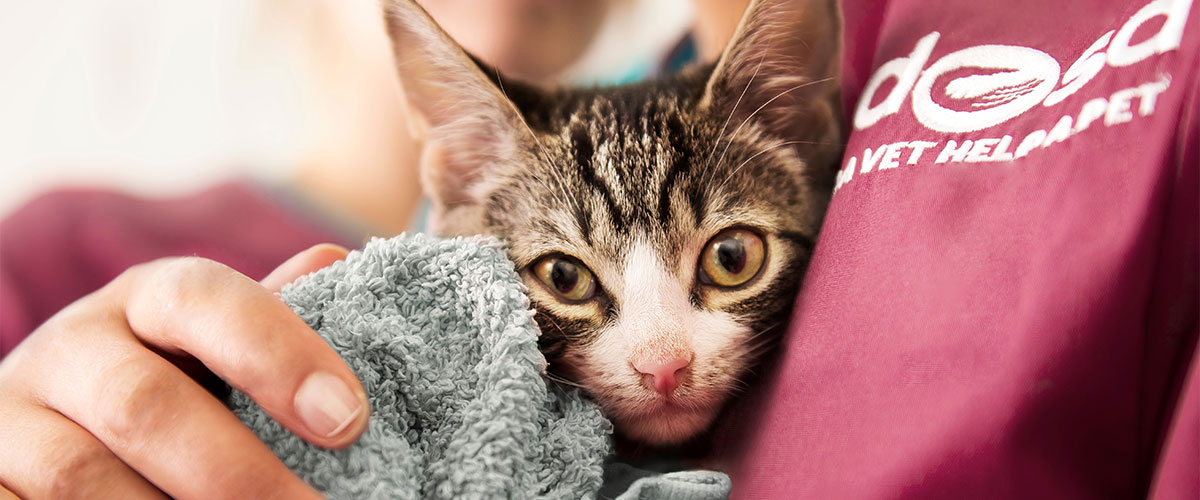How to stop cats jumping
Cats are curious animals who love to be up high because it can make them feel safer, which sometimes means they jump to places some people prefer they wouldn’t, like the kitchen worktop.
Trying to train your cat may seem impossible, but it can be done with a lot of patience and positive encouragement.
Keeping cats off worktops and furniture
A cat’s natural instinct is to jump and climb. It’s fun for them to do and forms part of their natural behaviour, but isn’t always enjoyable for their owners. If your cat keeps jumping onto a particular surface, firstly think about why. Is there food up there? Are there lots of ornaments and knick-knacks on that shelf? Is it just a really comfy sofa?
Take away the thing that interests them
If your cat is jumping because something on the shelf or worktop has caught their interest, try clearing it off. An empty shelf with no toys on it won’t be as fun for your cat. Try to keep kitchen work surfaces clear of food and anything else that may tempt your cat so they become boring for them. Remember to make sure they have plenty of alternative toys to play with in other places and that they are getting the correct diet for their age and weight.
Prevent access
If it’s not so much that they’re playing with things on a shelf or worktop but more that they’re just wandering all over it or using it as a bed, it can be helpful to block your cat from being able to jump on there. Place objects in the way so your cat can’t jump on the surface – so if your cat likes to jump on top of the fridge and you want to prevent them, stack your cookbooks there until they break the habit. Another option for some surfaces can be to temporarily place double-sided sticky tape on the surface – cats don’t like the sticky feeling of this under their paws. It’s important that you use something that will be there all the time and not something that depends on you using it, or your cat will learn they can still go up there when you’re not around.
Offer an alternative
If you’re not allowing your cat somewhere, it’s really important to make sure they can still have their fun elsewhere. Your cat might be climbing and jumping simply because they enjoy it and like to be up high, or it offers them a path to get elsewhere, or they want to be near you or watch you while you’re doing your thing. Offer them an alternative space that they are allowed to climb on that satisfies the same purpose. For example, if your cat likes to climb on your desk and wander all over your laptop or sit on important papers, put a cat bed on a side-table. This way they can still enjoy your company while you work, but they’re not in the way.
Cat trees can be a great way to offer your cat lots of different levels to explore. You can also use floating cat shelves as mounted platforms on your walls to provide paths to higher reaches. You can even put beds up here so they can spend time feeling safe and relaxed. Put toys on them to encourage your cat to use them and reward them when they do – for example with a healthy treat, playtime or petting, whichever they like best.
Play lots
Try to play with your cat as much as you can. This will make them happy, let them exercise their natural instincts and (hopefully) tire them out. The more they play with you, the less likely they are to get bored and want to go exploring where you don’t want them to. Remember to keep playtime interesting and varied by playing with different toys and alternating them regularly (every week is a good rule of thumb).
Be positive
Never punish your cat by shouting or hitting them or anything else like that for being where they shouldn’t, as it can cause them to become stressed and afraid of you. They will also still likely go in the places you don’t want them to, but just when you’re not around to tell them off. Instead, reward them for the good behaviour (like when they use the alternative you’ve provided) or encourage them to do something else if they look like they are about to jump somewhere they shouldn’t. We wouldn’t recommend using anything that might scare your cat when they jump onto a worktop or shelf, especially if it could cause them to panic and injure themselves. If your cat doesn’t mind being handled, you can pick them up and put them on your alternative place when they are somewhere you don’t want them to be. It’s important not to make a lot of fuss about it – simply move them quickly and gently and then ignore them afterwards.
Get them a cosy bed
If your cat likes curling up on the sofa, it might just be because it’s comfy and higher than the ground. Try to offer them an alternative bed (like a cat tree) that is raised off the ground. If you don’t mind your cat on the sofa but don’t want it covered in fur, put a blanket or cat bed down where your cat likes to sit. Remember to give your cat a brush to stop them shedding so much, which is especially important with any long haired cats.
Exercising cats
Keeping you cat in shape and healthy is important and can help to prevent them jumping.
Find out moreHomemade toys
You can make toys at home for your cat without breaking the bank. read our ideas.
Read moreStress in cats
It's important to be able to recognise when your cat is stressed and how to prevent it.
More info
